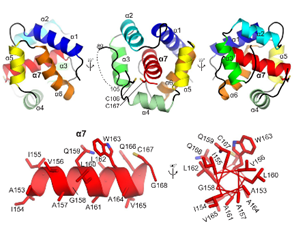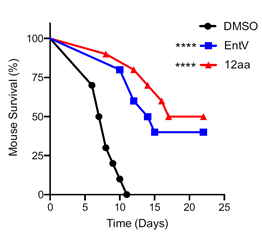Description:
Novel antifungal compositions that inhibit fungal growth which have both medical and non-medical utility and applications
Inventors at the University of Texas Health Science Center at Houston have developed a series of novel peptide compounds to inhibit fungal growth. The peptides are based on the bacteriocin EntV, which is secreted by Enterococcus faecalis. Studies in their lab have shown that the peptide is effective against Candida albicans infection not only in a C. elegans model but also in a mouse model of systemic infection and a rat model of venous catheter infection. Importantly, it was also demonstrated that the peptide was effective against Candida auris and Cryptococcus neoformans.
Components. The developed peptides were originally based on the bacteriocin EntV from Enterococcus faecalis. While the original active form of EntV is 68 amino acids, work from the inventors has shown that shorter fragments of the helix, down to 12 amino acids, exhibited full antifungal activity at nanomolar concentrations in in vitro assays and animal models of candidiasis, with even a 10mer variant retaining some function.
The 10mer was then used to generate a novel combinatorial library of peptides which were then screened to identify gain-of-function 10mers with antifungal activity equal to or greater than the 12mer, which had similar activity to the full-length EntV peptide.
Benefits/Technology Advantages. These peptides have promise as broad spectrum antifungal agents as the inventors have shown that they are active against at least some strains of Cryptococcus neoformans and the multi-drug resistant Candida auris. Thus, EntV-derived peptides are candidates for the development of anti-virulence agents for the treatment or prevention of fungal infections. As there are only three classes of drugs for systemic infections, this is an area of clear need.
Potential Applications. The obvious application for these compounds would be for the prevention and treatment of fungal infection; however, additional experiments have shown that the peptides could also be useful to pretreat implants, such as catheters to prevent subsequent infection and even incorporated into paint, films and other surfaces to prevent deterioration and inhibit fungal growth.


UTHealth Ref. No.: 2021-0018
Inventors: Dr. Danielle Garsin and Dr. Michael Lorenz
Intellectual Property Status: PCT/US2023/065708 Filed; Available for licensing
Stage of Development: Proof of concept in C. elegans, mice, and rats
Associated Publications: